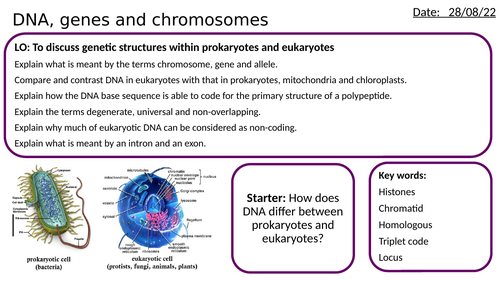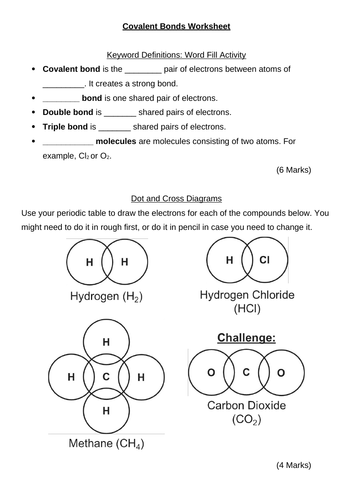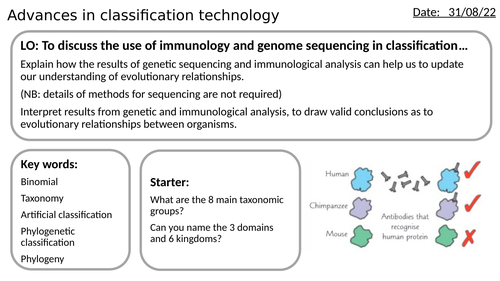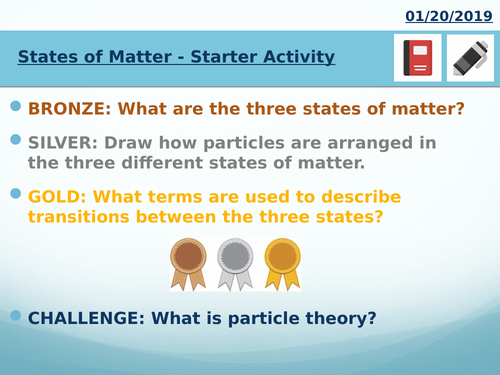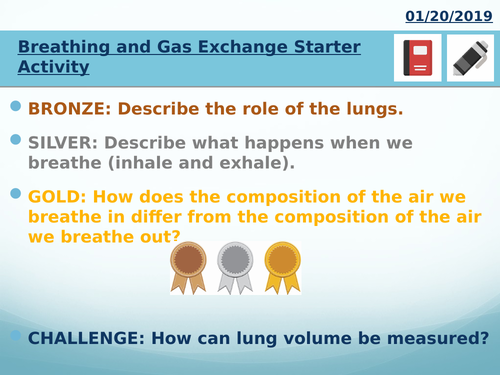63Uploads
16k+Views
13k+Downloads
All resources

AS/A2-Level AQA Biology Meiosis and Genetic Variation Full Lesson
A full 60 minute lesson on Meiosis, covering the following LOs…
Describe why meiosis is necessary.
Describe the process of meiosis.
Explain how meiosis creates genetic variation.
Lesson includes starter task, comprehension task, meiosis diagram sheet, summary questions (and answers), plenary, and also a homelearning task with practice exam questions (and mark scheme).

AS/A2-Level AQA Biology DNA, Genes and Chromosomes Full Lesson
A full 60 minute lesson on DNA, Genes and Chromosomes, covering the following LOs…
Explain what is meant by the terms chromosome, gene and allele.
Compare and contrast DNA in eukaryotes with that in prokaryotes, mitochondria and chloroplasts.
Explain how the DNA base sequence is able to code for the primary structure of a polypeptide.
Explain the terms degenerate, universal and non-overlapping.
Explain why much of eukaryotic DNA can be considered as non-coding.
Explain what is meant by an intron and an exon.
Lesson includes starter task, summary questions (and answers), and practice exam questions (and mark scheme).

AS/A2-Level AQA Biology B-Lymphocyte B-cell Antibodies Humoral Immunity Immune System Full Lesson
A full lesson on B-Lymphocytes, covering the following LOs…
Describe the humoral immune response.
Explain the roles played by B-cells and antibodies.
Explain the difference between the primary and secondary immune response.
Lesson includes starter task, practice exam questions (with mark scheme), and plenary.

AS/A2-Level AQA Biology Biodiversity (within a community) Full Lesson
A full 60 minute lesson on Biodiversity (within a community), covering the following LOs…
Explain what is meant by the terms biodiversity, species richness and index of diversity.
Calculate the index of diversity when supplied with relevant information.
Interpret information and draw conclusions from the index of diversity for different habitats.
Explain how farming techniques impact on biodiversity and the reason why these techniques are used.
Evaluate conservation techniques and why these must be balanced with farming.
Lesson includes starter task, recall questions (and answers), and also practice exam questions (and mark scheme).

AS/A2-Level AQA Biology Human immunodeficiency virus (HIV) AIDS Immune System Immunity Full Lesson
A full lesson on Human immunodeficiency virus (HIV), covering the following LOs…
Describe the structure of a HIV particle.
Explain how the structure of a HIV particle enables it to replicate within a helper T-cell.
Explain how HIV causes the symptoms of AIDs.
Lesson includes starter task, practice exam questions (with mark scheme), and plenary.

KS4 GCSE 9-1 Science Chemistry Covalent Bonds Bonding Worksheet
A worksheet about covalent bonds, with word fill and dot-cross diagram activities.

KS3/KS4 Chemistry Science Balancing Equations Bronze/Silver/Gold Worksheets (& Presentation)
Bronze (low ability), silver (medium ability), and gold (high ability) graded worksheets on balancing chemical equations. Students can start on bronze-level and work their way up to gold. Helps you to easily differentiate within the classroom. Useful for KS3, KS4, and all sciences.
Also contains a PowerPoint presentation with 3 examples to run through first! :)

AS/A2-Level AQA Biology Active Passive Natural Artificial Herd Immunity Vaccination Full Lesson
A full lesson on Active and Passive Immunity (Vaccination), covering the following LOs…
Describe how antigens can be used to produce a vaccine.
Discuss ethical issues associated with the use of vaccines.
Explain what is meant by herd immunity, and why it is able to protect unvaccinated people.
Compare and contrast active and passive, natural and artificial immunity.
Lesson includes starter task, recall questions (and answers), practice exam questions (with mark scheme), and plenary.

AS/A2-Level AQA Biology Structure and Types of Protein Amino Acids Biuret Test Full Lesson
A full lesson on Proteins, covering the following LOs…
The general structure of an amino acid.
The synthesis and breakdown of dipeptides and polypeptides, by the formation and breakage of peptide bonds.
The levels of protein structure.
The structure and function of globular proteins, including a conjugated protein.
The properties and functions of fibrous proteins.
How to carry out and interpret the results of the biuret test for proteins.
Lesson includes starter task, quick check questions, practice questions (with answers), and plenary task.

AS/A2-Level AQA Biology Advances in Classification Technologies Full Lesson
A full lesson on Advances in Classification Technologies, covering the following LOs…
Explain how the results of genetic sequencing and immunological analysis can help us to update our understanding of evolutionary relationships.
Interpret results from genetic and immunological analysis, to draw valid conclusions as to evolutionary relationships between organisms.
Lesson includes starter task, and practice exam questions (and mark scheme).

AS/A Level Year 12/13 Biology Biological Molecules Carbohydrate Revision Cards
PowerPoint Presentation containing printable “fill the gap” revision cards (plus answers) for AS/A Level Year 12/13 (OCR) Biology (Biological Molecules) Carbohydrate Lessons.
Cards include:
Monosaccharides - alpha-glucose, beta-glucose, and ribose.
Disaccharides - maltose, sucrose, and lactose.
Polysaccharides - amylose/amylopectin (starch), glycogen, and cellulose (how their structure is related to their function).
Glycosidic bonds, condensation reactions, and hydrolysis reactions.
All cards are colour-coded, numbered, and link to each other.

AS/A Level Year 12/13 Biology Biological Molecules Roles of Lipids Full Lesson
Full Year 12 (AS) lesson on the roles of lipids, with starter activity (true or false), main activity (summarise the provided article), and multiple choice questions to finish.

KS3/KS4 Chemistry Science States of Matter Full Lesson with worksheet and answers
Full lesson with differentiated starter questions, quick check true or false questions, and worksheet with answers.

KS3/KS4 Biology Gas Exchange System Lungs Breathing Respiration Full Lesson
Whole lesson PowerPoint containing…
BRONZE/SILVER/GOLD differentiated starter questions
Learning objectives
Numeracy activity labeling the structure of the gas exchange system
How we inhale/exhale
Links to aerobic respiration
How the lungs are adapted to gas exchange
Composition of the air we inhale and exhale
How lung volume is measured
QUICK CHECK true or false questions
What have I learnt today plenary.

AS/A2-Level AQA Biology Lipids Triglycerides Phospholipids Emulsion Test Full Lesson
A full lesson on Lipids, covering the following LOs…
Describe the structure of a triglyceride.
Recognise saturated or unsaturated fatty acids.
Describe the formation of a triglyceride.
Explain how the structures of triglycerides are related to their function.
Describe the structure of a phospholipid.
Explain how the structures of phospholipids are related to their function.
Describe the test for lipids.
Lesson includes starter task, quick check questions, plenary (do now task), and also an emulsion test student practical worksheet.

AS/A2-Level AQA Biology Protein Synthesis - Transcription Full Lesson
A full lesson on Transcription (Protein Synthesis), covering the following LOs…
Explain what the terms genome and proteome mean.
Describe the structure of mRNA and how it is related to its function (link to biological molecules topic).
Explain the process of transcription in prokaryotes.
Explain the process of transcription and splicing in eukaryotes, linking this to knowledge of introns.
Interpret data from experimental work investigating the role of nucleic acids.
Lesson includes starter task and summary questions (and answers).

AS/A2-Level AQA Biology Protein Synthesis - Translation Full Lesson
A full lesson on Translation (Protein Synthesis), covering the following LOs…
Explain the process of translation.
Explain the specific roles of ribosomes, ATP and tRNA in translation.
Describe the structure of tRNA and how it is related to its function.
Relate the base sequence of nucleic acids to the amino acid sequence of polypeptides, when provided with suitable data about the genetic code.
Lesson includes starter task, summary questions (and answers), and practice exam questions (and mark scheme).

AS/A2-Level AQA Biology Testing for Carbohydrates Iodine Test Benedict's Test Full Lesson
A full lesson on Testing for Carbohydrates, covering the following LOs…
Describe the test for reducing and non-reducing sugars.
Explain when the Benedict’s test can be described as both qualitative, semi-quantitative and quantitative.
Analyse results obtained from the Benedict’s test.
Lesson includes starter task, summary questions (with answers), and practice questions (with mark scheme).

GCSE 9-1 Science Biology Nervous System Neurone Voluntary Involuntary Actions Reflex Arc Full Lesson
Full lesson on voluntary vs involuntary reactions, 3 different types of neurones (sensory, relay and motor), and reflex arcs.

AS/A2-Level AQA Biology Phagocytosis Phagocyte Non-Specific Immune System Full Lesson
A full lesson on Phagocytosis, covering the following LOs…
Describe the process of phagocytosis.
Explain the role of lysozymes in the destruction of pathogens.
Explain the role of antigen presentation following destruction.
Lesson includes starter task, application questions (with answers), and practice exam questions (and mark scheme).


